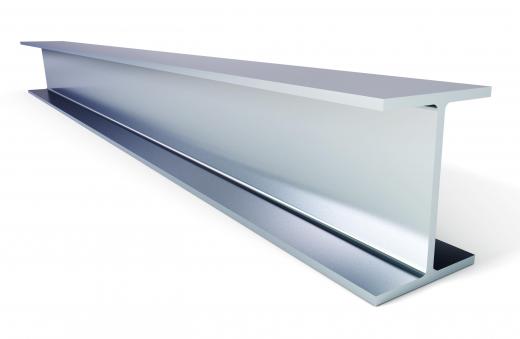What is Flexural Modulus?
Flexural modulus is a measure of how a certain material will strain and potentially even deform when weight or force is applied to it. This is an important calculation in engineering and architectural fields, since it tells builders and designers the maximum weight that different materials can bear. Calculations often shape choices made in the building and design of everything from skyscrapers and homes to industrial machinery, cars, and basic consumer appliances. As a result, it plays an important role in civil, mechanical, and aerospace engineering and design, and is frequently used to select the correct materials for parts that will support loads without flexing or warping.
Differences in Material

In basic terms, the calculation describes the ability of a material with a specific cross-section to resist bending when placed under stress. The number necessarily varies depending on what sort of material is at issue, though. Even surfaces and structures that look comparable can have different capacities when it comes to weight-bearing ability.
Ductile materials like steel and brass, which can be deformed a great deal before failure, have a well-defined modulus ranking, for example. Brittle materials like glass and concrete typically have little or no plastic deformation before failure. For this reason, many brittle materials do not have a clearly defined measurement, and they are often described by their flexural strength — which is the maximum amount of bending stress that can be applied before rupture or failure of the material occurs.
Relationship Between Stress and Strain

The term is used to define the relationship between a bending stress and the resulting strain. Strain is a measure of the amount that a material will deform when a stress is applied. Elastic strain is reversible and will disappear after the stress is removed, meaning that the material will return to its original state. At high levels of stress, however, a material will permanently deform and will usually not return to its original dimensions. This is referred to as “plastic strain” or “yielding.”
Plotting the Curve

Engineers and architects typically plot out the modulus on a graph that can serve as a visual representation of the interplay between stress and strain. The result is typically known as a “stress-strain curve,” and it shows how strain changes with applied bending stress. The slope of this curve in the region where elastic strain occurs defines the flexural modulus of the material. The units of measure are, in most cases, pounds per square inch (psi) or Newtons per square meter, perhaps more commonly known as pascals (Pa).
Lab Tests
Actually getting a precise measurement of flexural modulus can be somewhat complicated, but is almost always determined through a series of intensive laboratory tests. In most cases engineers will start with a sample of the target material with a specific shape and known dimensions. The “flexural test” is essentially a measurement of the force necessary to bend a sample, often known as a “beam,” that has defined dimensions. Technicians typically apply force at three points: the beam is usually supported on the bottom side near both ends and a force is applied to the top at the center point, between the bottom supports. This is known as three-point loading conditions. Once the force has been entered, any deflection or movement of the beam is measured and recorded, and then later analyzed.
Flexural modulus has been determined for a wide variety of structural materials, including metals, wood, glass, concrete, and plastics. It is usually measured at ambient temperature conditions. The properties of some materials, like many plastics, will change with temperature. The flexural test is sometimes conducted at lower or higher temperatures to simulate the intended end-use environment; this sort of knowledge is really important for people building at high altitudes or in extreme climate conditions, particularly in arctic zones or near the equator.
AS FEATURED ON:
AS FEATURED ON:













Discussion Comments
anumeya: flexural stress is highest stress within material at its moment of rupture while as flexural modulus is the ratio of stress to strain in flexural defomation.
@anon295089: It is easier to understand if you look at the stress strain graphs. What you're describing is that some materials don't have a high enough slope (flexural modulus) although they do reach the flexural stress desired (I am assuming it is yield flexural stress). In other words, it is too bendable, even if it doesn't break.
The other case is that the material has the right slope (flexural modulus), meaning it is stiff enough. However, it just isn't strong enough to handle the flexural stress desired.
Disclaimer: I'm only a third year undergrad. What I post is in no way professional advice and I am not giving it as such. Please consult someone else who is qualified if you are going to do job related stuff. I am only giving my 2 cents for our mutual edification.
I am a construction inspector and I have a problem interpreting the test results submitted to us. For example, the contract specs for mechanical testing call for a flexural stress of at least 4,000 psi. at 5 percent strain, and for a Flexural Modulus of at least 300,000 psi.
My problem is that some materials passed the flexural stress but failed to meet the Flexural Modulus requirement, and for other samples its the other way around.
In a structural perspective, could anyone out there help educate me as to what these test results really mean?
@JackWhack – It sounds strange, but glass would have a larger elastic modulus than rubber. This is because elastic modulus measures stress changes when strain is applied.
So, though rubber would bend much further because it is more elastic, it is actually stronger than the glass when tension is being measured. The glass will break long before the rubber will.
I can see how glass would yield to stress suddenly instead of deforming. With something as thick and as sturdy as glass, you will either hear it break or hear it do nothing at all.
This flexular modulus definition reminds me of what we did in high school to determine how strong our wooden bridges were. The teacher had divided us into teams and instructed us to come up with bridge designs, and the team with the strongest bridge would win.
We stressed the bridges until they snapped. The ones that could deal with the most strain resulted in better grades.
Post your comments